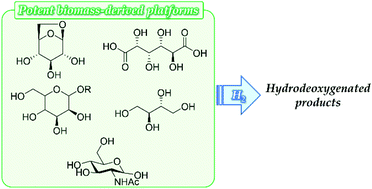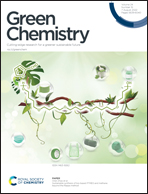Hydrodeoxygenation of potential platform chemicals derived from biomass to fuels and chemicals†
Abstract
Biomass valorization has emerged as a promising and sustainable means of accommodating value-added chemicals. To produce such chemicals, various transformation methods of the top biomass-derived platform chemicals nominated by the U.S. Department of Energy (DOE) have been extensively investigated in recent decades. However, as represented by 5-hydroxymethylfurfural, which is one of the most widely investigated top platform chemicals, their use is still under development due to difficulties in their production, handling, and selective transformation. In this context, revisiting the U.S. DOE's lists and refocusing on other potent platform chemicals are beneficial for this research field. This review introduces such platform chemicals, viz., levoglucosan (+levoglucosenone), alkyl glycosides, glucaric acid, erythritol (+1,4-anhydroerythritol), and N-acetylglucosamine. Hydrodeoxygenation to remove oxygenated functionalities partially or completely using hydrogen as a reductant is a promising means of upgrading these compounds to fuels and useful chemicals, whose production is difficult from conventional top platform chemicals. Herein, a variety of catalytic systems to achieve the selective hydrodeoxygenation of the compounds introduced above are summarized with a description of their features, including catalytic performance, active sites, and mechanism.

- This article is part of the themed collections: Green Chemistry Reviews and 2022 Green Chemistry Hot Articles


 Please wait while we load your content...
Please wait while we load your content...